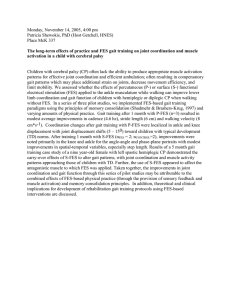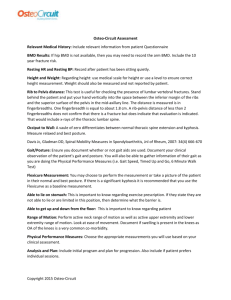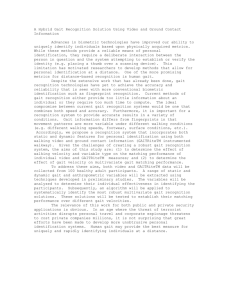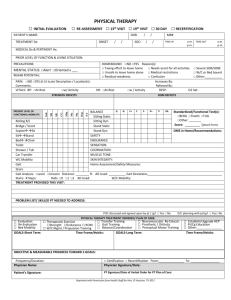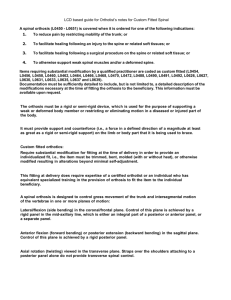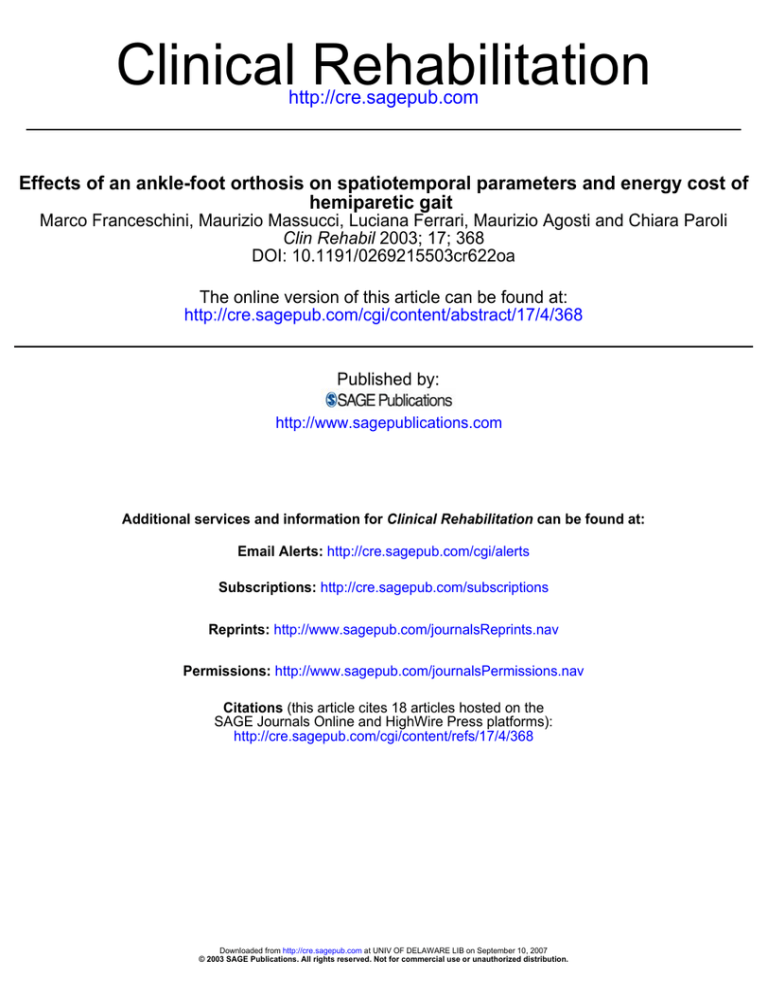
Clinical Rehabilitation
http://cre.sagepub.com
Effects of an ankle-foot orthosis on spatiotemporal parameters and energy cost of
hemiparetic gait
Marco Franceschini, Maurizio Massucci, Luciana Ferrari, Maurizio Agosti and Chiara Paroli
Clin Rehabil 2003; 17; 368
DOI: 10.1191/0269215503cr622oa
The online version of this article can be found at:
http://cre.sagepub.com/cgi/content/abstract/17/4/368
Published by:
http://www.sagepublications.com
Additional services and information for Clinical Rehabilitation can be found at:
Email Alerts: http://cre.sagepub.com/cgi/alerts
Subscriptions: http://cre.sagepub.com/subscriptions
Reprints: http://www.sagepub.com/journalsReprints.nav
Permissions: http://www.sagepub.com/journalsPermissions.nav
Citations (this article cites 18 articles hosted on the
SAGE Journals Online and HighWire Press platforms):
http://cre.sagepub.com/cgi/content/refs/17/4/368
Downloaded from http://cre.sagepub.com at UNIV OF DELAWARE LIB on September 10, 2007
© 2003 SAGE Publications. All rights reserved. Not for commercial use or unauthorized distribution.
Clinical Rehabilitation 2003; 17: 368–372
Effects of an ankle-foot orthosis on spatiotemporal
parameters and energy cost of hemiparetic gait
Marco Franceschini Department of Geriatrics and Rehabilitation, Hospital of Parma, Maurizio Massucci Department of
Rehabilitation – Trevi (Pg), ASL n° 3 of Umbria, Luciana Ferrari, Maurizio Agosti and Chiara Paroli Department of
Geriatrics and Rehabilitation, Hospital of Parma, Italy
Received 30th September 2001; returned for revisions 2nd November 2001; revised manuscript accepted 16th February
2002.
Objective: To assess the effect of an ankle-foot orthosis on the gait and
energy parameters of walking in chronic hemiparetic subjects.
Design: With/without group comparison.
Setting: Consecutive patients recruited from the gait analysis laboratory of
our rehabilitation department.
Subjects: A group of nine chronic hemiparetic patients, with the same gait
pattern alteration, were evaluated during walking at free speed with and
without the use of an orthosis.
Outcome measures: Gait analysis and study of energy cost.
Results and conclusion: The orthosis signicantly improved self-selected
speed (15.47 versus 21.39 m/min), stride cycle (2.33 versus 2.08 s), stance
(1.83 versus 1.48 s) and double support (1.55 versus 1.16 s) and reduced
energy cost (0.76 versus 0.49 ml O 2/kg/m) of walking without affecting
cardiorespiratory response. Moreover, a signicant correlation was found
between the improvement of double support and the reduction of energy
cost.
Introduction
In hemiplegic patients spatiotemporal parameters are signicantly different from those of
healthy subjects: speed is lower, the rate and
length of steps are lower, the swing phase of the
affected limb is shorter, and the stance phase of
the uninvolved leg is longer.1–3 Hemiplegic gait
implies fatigue and higher energy cost compared
Address for correspondence: Marco Franceschini, Department of Geriatrics and Rehabilitation – Ospedale Maggiore
di Parma, Via Abbeveratoia 8/a – 43100 Parma, Italy. e-mail:
franceschini@ao.pr.it
© Arnold 2003
with normal walking.4,5 Orthoses can limit kinesiological problems of the foot–ankle complex,
improve the stride’s spatiotemporal parameters,6
and lower the energy cost of walking.7 The aim
of this study was to assess the effect of an anklefoot orthosis (AFO) on the gait and energy
parameters of walking in a group of chronic
hemiparetic individuals.
Materials and methods
Nine consecutive hemiplegic subjects referred to
the gait analysis laboratory of our rehabilitation
Downloaded from http://cre.sagepub.com at UNIV OF DELAWARE LIB on September 10, 2007
© 2003 SAGE Publications. All rights reserved. Not for commercial use or unauthorized distribution.
10.1191/0269215503cr622oa
Effects of an AFO on hemiparetic gait
department were enrolled in the study. All had
completed an intensive rehabilitation programme, were able to walk independently for at
least 6 min, with or without walking aids, and
shared a similar kinesiological foot–ankle disorder with a swing phase characterized by hypertonic equinus. None had any symptoms indicating
a cardiopulmonary disorder. Six were men and
three women. Three suffered from right hemiparesis and six from left hemiparesis. The mean
age was 66.5 ± 16.4 years. The duration of hemiplegia varied from two months to 244 months.
(median 39). Three patients used a cane. Each
individual used a foot-ankle orthosis adjusted to
his or her kinesiological disorder.
The BTS telemetric system (BTS, Italy) was
used for gait analysis. The patient was asked to
walk 10 metres in a straight line at self-selected
speed. At least three measurements were made
for each patient. The measurements were: stride
time, stance time, swing time, single and double
support time. These parameters were also
expressed as a percentage of the stride cycle time.
Metabolic parameters of gait were measured
with miniature telemetry equipment (Cosmed
K2) described in detail elsewhere.8 This system
simultaneously analysed oxygen concentration of
the exhaled air and cardiorespiratory parameters.
The system is user-friendly, accurate and reliable
compared with standard breath to breath
systems.9 Each test was performed in the morning 3 hours after breakfast, 1 hour after the gait
analysis.
The experimental procedure was as follows: 3
min in sitting position and 6 min of continuous
walking at a comfortable self-selected speed.
Patients walked along a hospital corridor of
known length. The average speed was calculated
Table 1
369
dividing the distance covered by the 6 min of
walking. The cardiorespiratory parameters
analysed were: ventilation per minute (VE),
heart rate (HR), respiratory rate (RR) and oxygen uptake. We use the term energy consumption per kilogram mass per minute to indicate the
oxygen uptake divided by the patient’s weight.
Dividing this value by the speed, the energy cost
per kilogram per unit of distance covered is
obtained.
The comparison between parameters was performed using nonparametric statistics (Wilcoxon
test) as well as the tests of correlation between
variables (Pearson’s rho correlation index).
Results
There was a signicant reduction in the duration
of the stride cycle in the gait with an orthosis
(respectively 2.33 versus 2.08 s, p < 0.016 and 2.34
versus 2.08 s, p < 0.016), the duration of the
stance phase (respectively: 1.83 versus 1.48 s,
p < 0.016 and 2.06 versus 1.76 s, p < 0.011) and
the duration of double support (respectively: 1.55
versus 1.16 s, p < 0.011 and 1.55 versus 1.17 s,
p < 0.011 respectively). The orthosis led to a
signicant increase in the self-selected speed
(p < 0.001) and a signicant reduction in energy
cost of walking (p < 0.01), but did not signicantly affect energy consumption and cardiorespiratory parameters (Table 1).
Statistical correlation shows an inverse relation
between energy cost and walking speed without
(r = –0.80, p = 0.008) and with (r = –0.82, p =
0.006) the orthosis. No signicant correlation
exists between energy cost and double support in
walking without an orthosis for the healthy and
Effects of orthosis on energy cost and functionality of walking
Without orthosis
Energy cost (ml O2/kg/m)
Energy consumption (ml O 2/kg/min)
Speed (m/min)
HR (beats/min)
RR (breaths/min)
With orthosis
Average
SD
Average
SD
p-value
0.76
9.87
15.47
89.14
22.25
0.41
1.92
6.95
13.36
3.27
0.49
9.42
21.39
87.88
23.31
0.20
1.62
7.30
13.43
4.25
<0.01
NS
<0.001
NS
NS
SD, standard deviation; HR, heart
rate; from
RR,http://cre.sagepub.com
respiratory rate.
Downloaded
at UNIV OF DELAWARE LIB on September 10, 2007
© 2003 SAGE Publications. All rights reserved. Not for commercial use or unauthorized distribution.
370
M Franceschini et al.
(a)
(b)
Figure 1 Correlation between energy cost and double support (a) without orthosis (Pearson’s
correlation r = 0.36, p = NS) and (b) with orthosis (Pearson’s correlation r = 0.78, p < 0.05).
the weak side (r = 0.36, in both cases). Such a correlation is instead present in the walking with the
orthosis (r = 0.78, p < 0.05 for the healthy and the
plegic side) (Figure 1a,b).
Discussion
Clinical messages
An ankle-foot orthosis in chronic hemiplegic subjects may correct the pattern of
gait and signicantly improve the functionality of walking and spatiotemporal parameters.
This may be because an AFO reduces the
energy cost of gait, without affecting energy
consumption or cardiorespiratory response.
An AFO or other intervention may improve both
energetic7,10–13 and spatiotemporal6,14–16 parameters of the stride. Besides conrming this, our
study also showed improved energy efciency.
The speed/energy cost ratio
of from
gait,
intended as
Downloaded
http://cre.sagepub.com
at UNIV OF DELAWARE LIB on September 10, 2007
© 2003 SAGE Publications. All rights reserved. Not for commercial use or unauthorized distribution.
Effects of an AFO on hemiparetic gait
oxygen consumption per kilogram body weight
per metre walked, is curvilinear, both in healthy
and hemiplegic individuals.17 The energy consumption of gait, as oxygen consumption per
kilogram body weight per minute, increases proportionally to the increase of the workload (i.e.,
of speed).18
The reduction in energy cost of gait with the
orthosis detected by our study may stem from the
biomechanical effectiveness of the AFO or from
the speed increase itself. Though it is clear that
only a comparison of gait with and without an
orthosis at the same speed would provide a denitive answer, our data may indirectly suggest that
the rst hypothesis is not to be ruled out because,
even though the speed is higher when patients
use AFO, energy consumption and cardiorespiratory parameters do not increase implying that
the body’s workload does not increase in spite of
the higher speed. This is probably due to a facilitating biomechanical effect of the orthosis.
The double support’s duration seems to be the
parameter that best represents the benet provided by the orthosis in terms of energy. The
double support in fact correlates signicantly
with energy cost only in gait with AFO. Free
speed, as expected, will instead correlate with
energy cost both with and without an orthosis.
Improvement in the stride’s energy and time
parameters with the use of an orthosis could also
be linked to an improvement in the stride pattern.19,20 An orthosis can improve an abnormal
base of support and limb instability during the
stance phase and improve the limb clearance and
limb advancement during the swing phase.21 The
orthosis clearly leads to a substantial change in
the locomotor pattern which provides greater stability to the plegic side in the stance phase.6,15,16
371
2 Hill KD, Goldie PA, Baker PA, Greenwood KM.
Retest reliability of the temporal and distance
characteristics of hemiplegic gait using a footswitch
system. Arch Phys Med Rehabil 1994; 75: 577–83.
3 Waters RL, Mulroy Sara. The energy expenditure of
normal and pathologic gait. Gait Posture 1999; 9:
207–31.
4 Onley SJ, Monga TN, Costigan PA. Mechanical
energy of walking of stroke patients. Arch Phys Med
Rehabil 1986; 67: 92–98.
5 Fischer SV, Gullickson G. Energy cost of
ambulation in health and disability: a literature
review. Arch Phys Med Rehabil 1978; 59: 124–33.
6 Burdett RG, Borello-France D, Blatchly C, Potter
C. Gait comparison of subjects with hemiplegia
walking unbraced, with ankle-foot orthosis, and with
air-stirrup brace. Phys Ther 1988; 68: 1197–203.
7 Corcoran PJ, Jebsen RH, Brengelmann GI et al.
Effects of plastic metal leg braces on speed and
energy cost of hemiparetic ambulation. Arch Phys
Med Rehabil 1970; 51: 69–77.
8 Crandall CG, Taylor SL, Raven PB. Evaluation of
the Cosmed K2 portable telemetric oxygen uptake
analyzer. Med Sci Sports Exerc 1994; 26: 108–11.
9 Lucia A, Fleck SJ, Gotshall RW, Kearney GT.
Validity and reliability of the Cosmed K2
instrument. Int J Sports Med 1993; 14: 380–86.
10 Tyson SF, Thornton HA. The effect of a hinged
ankle foot orthosis on hemiplegic gait: objective
measures and users’ opinions. Clin Rehabil 2001; 15:
53–58.
11 Lehmann JF, Condon SM, Price R, deLateur BJ.
Gait abnormalities in hemiplegia: their correction by
ankle-foot orthoses. Arch Phys Med Rehabil 1987;
68: 763–71.
12 Zamparo P, Pagliaro P. The energy cost of level
walking before and after hydro-kinesi therapy in
patients with spastic paresis. Scand J Med Sci Sports
1998; 8: 222–28.
13 Corcoran PJ. Evaluation of plastic short leg brace.
Thesis, University of Washington, Seattle, 1968.
14 Hesse S, Luecke D, Jahnke MT, Maurits KH. Gait
function in spastic hemiparetic patients walking
barefoot, with rm shoes, and with ankle-foot
orthosis. Int J Rehabil Res 1996; 19: 133–41.
Acknowledgements
15 Hesse S, Werner C, Matthias K, Stephen K,
Berteanu M. Non-velocity related effects of a rigid
The authors would like to thank Dr Lorenzo
double stopped ankle-foot orthosis on gait and lower
Spizzichino for his help in the statistical analysis
limb muscle activity of hemiparetic subjects with an
of the data.
equinovarus deformity. Stroke 1999; 30: 1855–61.
16 Diamond MF, Ottembacher KJ. Effect of a
tone-inhibiting dynamic ankle-foot orthosis on stride
References
characteristics of an adult with hemiparesis. Phys
Ther 1990; 70: 423–30.
17 Zamparo P, Francescato MP, De Luca G, Lovati L,
1 Holden MK, Gill KM, Magliozzi MR. Gait
di Prampero PE. The energy cost of level walking in
assessment for neurologically impaired patients:
Standards for outcome assessment. Phys Ther 1986;
patients with hemiplegia. Scand J Med Sci Sports
66: 1530–39.
1995; 5:
Downloaded from http://cre.sagepub.com at UNIV OF DELAWARE
LIB 348–52.
on September 10, 2007
© 2003 SAGE Publications. All rights reserved. Not for commercial use or unauthorized distribution.
372
M Franceschini et al.
18 Waters RL, Hislop EJ, Perry J, Antonelli D. Energy
cost of normal and pathologic gait. Orthop Clin
North Am 1978; 9: 351–77.
19 Lehmann JF. Biomechanics of ankle-foot orthoses:
prescription and design. Arch Phys Med Rehabil
1979; 60: 200–207.
20 Perry J, Montgomery J. Gait of the stroke patient
and orthotic indications. Stroke Rehabil 1987;
246–83.
21 Esquenazi A, Hirai B. Assessment of gait and
orthotic prescription. Phys Med Rehabil Clin North
Am 1991; 2: 473–85.
Downloaded from http://cre.sagepub.com at UNIV OF DELAWARE LIB on September 10, 2007
© 2003 SAGE Publications. All rights reserved. Not for commercial use or unauthorized distribution.



